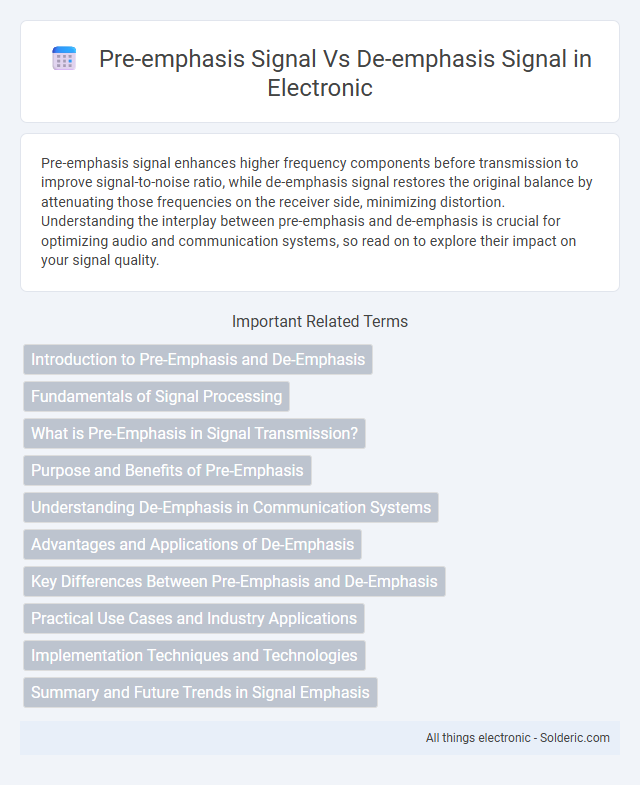Pre-emphasis signal enhances higher frequency components before transmission to improve signal-to-noise ratio, while de-emphasis signal restores the original balance by attenuating those frequencies on the receiver side, minimizing distortion. Understanding the interplay between pre-emphasis and de-emphasis is crucial for optimizing audio and communication systems, so read on to explore their impact on your signal quality.
Comparison Table
| Aspect | Pre-emphasis Signal | De-emphasis Signal |
|---|---|---|
| Purpose | Enhance high-frequency components before transmission | Reduce enhanced high-frequency components after reception |
| Function | Boosts high-frequency signals to improve signal-to-noise ratio (SNR) | Attenuates high-frequency signals to restore original signal balance |
| Application | Used at transmitter end in audio and communication systems | Used at receiver end in audio and communication systems |
| Benefit | Reduces high-frequency noise impact during transmission | Restores audio fidelity by compensating pre-emphasis boost |
| Effect on Noise | Improves noise immunity by emphasizing higher frequencies | Removes noise amplification caused by pre-emphasis |
| Typical Frequency Range | Above 1 kHz (varies by standard, e.g., FM broadcasting) | Same as pre-emphasis to match the boost applied |
Introduction to Pre-Emphasis and De-Emphasis
Pre-emphasis and de-emphasis are critical techniques in signal processing aimed at improving signal-to-noise ratio during transmission and reception. Pre-emphasis boosts the amplitude of high-frequency components before transmission to counteract potential signal degradation, while de-emphasis attenuates these frequencies at the receiver end to restore the original signal balance. These processes are widely used in audio broadcasting and communication systems to reduce noise and enhance overall signal clarity.
Fundamentals of Signal Processing
Pre-emphasis and de-emphasis are critical techniques in signal processing used to improve the signal-to-noise ratio in audio transmissions. Pre-emphasis boosts the amplitude of higher frequency signals before transmission, reducing the impact of high-frequency noise. De-emphasis, applied at the receiver end, attenuates the high frequencies back to their original levels, ensuring your audio signals maintain clarity and fidelity.
What is Pre-Emphasis in Signal Transmission?
Pre-emphasis in signal transmission is a technique that amplifies the higher frequency components of a signal before transmission to improve the signal-to-noise ratio and reduce high-frequency noise. This process boosts frequencies that are more susceptible to attenuation during transmission, ensuring clearer and more reliable reception. De-emphasis is applied at the receiver to restore the original signal balance by attenuating the amplified high frequencies, effectively reducing noise introduced during transmission.
Purpose and Benefits of Pre-Emphasis
Pre-emphasis boosts the high-frequency components of an audio or communication signal before transmission to improve the signal-to-noise ratio and reduce the effects of noise and interference. This process enhances the overall clarity and intelligibility of the signal, especially in environments with significant high-frequency attenuation. Your receiver then uses de-emphasis to restore the original frequency balance, ensuring accurate sound reproduction and minimizing distortion.
Understanding De-Emphasis in Communication Systems
De-emphasis in communication systems reduces high-frequency noise introduced during transmission by applying a frequency response inverse to pre-emphasis. Your receiver uses de-emphasis filters to restore the original signal's amplitude balance, improving audio clarity and reducing distortion. Understanding this process is essential for optimizing signal quality in FM radio, audio broadcasting, and other communication technologies.
Advantages and Applications of De-Emphasis
De-emphasis reduces high-frequency noise amplified during the pre-emphasis stage, improving overall signal-to-noise ratio and audio clarity in communication systems. Its primary application lies in FM broadcasting, where it counteracts pre-emphasis applied at the transmitter to maintain audio fidelity and reduce distortion. De-emphasis circuits are essential in radio receivers, audio processing equipment, and digital communication systems to ensure accurate signal recovery and enhanced listening experience.
Key Differences Between Pre-Emphasis and De-Emphasis
Pre-emphasis boosts the high-frequency components of a signal before transmission to improve signal-to-noise ratio and reduce the impact of high-frequency noise. De-emphasis, applied at the receiver end, attenuates these same frequencies to restore the original signal balance and ensure audio fidelity. The key difference lies in their roles: pre-emphasis enhances certain frequencies to protect signal quality during transmission, while de-emphasis reverses this effect to recover the intended audio spectrum.
Practical Use Cases and Industry Applications
Pre-emphasis signals enhance high-frequency components to improve signal-to-noise ratio during transmission, commonly used in FM broadcasting, audio recording, and telecommunications to reduce noise and distortion. De-emphasis signals then restore the original frequency balance at the receiver end, essential in audio playback devices and radio receivers to ensure sound fidelity and clarity. Your audio systems benefit from this pair of techniques to maintain signal integrity across long distances and noisy environments.
Implementation Techniques and Technologies
Pre-emphasis and de-emphasis signals are implemented using analog or digital filters designed to modify frequency response for noise reduction in communication systems. Pre-emphasis often employs a high-pass filter to boost high-frequency components before transmission, while de-emphasis applies a complementary low-pass filter at the receiver to restore original signal balance. Your choice of implementation technique depends on system requirements, with digital signal processing (DSP) technologies enabling precise control and adaptability in modern communication devices.
Summary and Future Trends in Signal Emphasis
Pre-emphasis signals enhance high-frequency components to improve signal-to-noise ratio in transmission systems, while de-emphasis signals restore the original signal profile by attenuating those frequencies at the receiver end. Advances in adaptive filtering and machine learning algorithms are driving the development of dynamic emphasis techniques, optimizing performance in real-time communication environments. Future trends emphasize integration with cognitive radio and 5G/6G technologies to enable more efficient noise reduction and bandwidth utilization in complex signal processing tasks.
pre-emphasis signal vs de-emphasis signal Infographic

 solderic.com
solderic.com